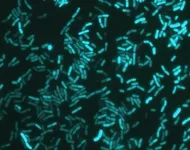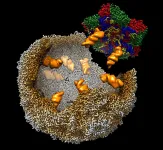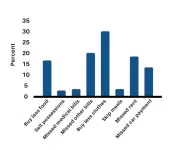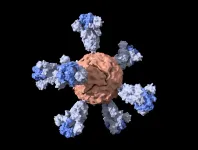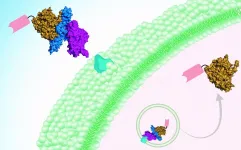Immune cells discovered in the lungs improve virus defense
2021-01-08
(Press-News.org) A research team at the University of Basel has discovered immune cells resident in the lungs that persist long after a bout of flu. Experiments with mice have shown that these helper cells improve the immune response to reinfection by a different strain of the flu virus. The discovery could yield approaches to developing longer-lasting vaccinations against quickly-mutating viruses.
At the start of the coronavirus pandemic, some already began to raise the question of how long immunity lasts after weathering SARS-CoV-2. The same question has now arisen regarding the COVID-19 vaccination. A key role is played by immunological memory - a complex interplay of immune cells, antibodies and signaling substances that allows the body to fight off known pathogens very efficiently.
Researchers led by Professor Carolyn King from the University of Basel's Department of Biomedicine have now identified a diverse group of immune cells in the lungs that are key to the defense against reinfection by flu viruses. The same could be true of reinfection by other pathogens that cause respiratory diseases.
In experiments with mice, the researchers characterized a group of memory T cells in lung tissue that remain for a long time after a bout of flu. The team reports on these "T resident helper cells" in the peer-reviewed journal Science Immunology.
Reservoir inside tissue
"Relatively little is known about memory T cells that remain in tissue," explained Nivedya Swarnalekha, co-first author of the study. Previous studies have focused on memory cells in blood and lymphatic tissue. "But it makes sense that the body keeps a reservoir of these cells in the tissues affected by the infection, where the same or similar pathogens could invade again."
In their study, the researchers describe two types of T helper cells in the lungs. One type releases signaling substances in case of reinfection to equip other immune cells with deadlier "weapons" in the fight against the pathogen. The other type, previously characterized primarily in lymphatic tissue and thought to be absent in lung tissue, assists antibody-producing immune cells (B cells) and localizes closely with them in the lung.
The researchers were able to show that the presence of these cells in the direct proximity of the antibody-producing B cells led to a more efficient immune response against a different flu virus.
Starting point for long-term vaccine protection
"These T helper cells could be an interesting starting point for longer-lasting flu vaccinations," says David Schreiner, the other co-first author of the study, adding that it might be possible, for example, to supplement vaccines with agents that promote the formation of these T helper cells which migrate into the tissue. To that end, further research and development are needed.
INFORMATION:
ELSE PRESS RELEASES FROM THIS DATE:
2021-01-08
Humans have them, so do other animals and plants. Now research reveals that bacteria too have internal clocks that align with the 24-hour cycle of life on Earth.
The research answers a long-standing biological question and could have implications for the timing of drug delivery, biotechnology, and how we develop timely solutions for crop protection.
Biological clocks or circadian rhythms are exquisite internal timing mechanisms that are widespread across nature enabling living organisms to cope with the major changes that occur from day to night, even across seasons.
Existing inside cells, these molecular rhythms use external cues such as daylight and temperature to synchronise ...
2021-01-08
CORVALLIS, Ore. - Efficiently mass-producing hydrogen from water is closer to becoming a reality thanks to Oregon State University College of Engineering researchers and collaborators at Cornell University and the Argonne National Laboratory.
The scientists used advanced experimental tools to forge a clearer understanding of an electrochemical catalytic process that's cleaner and more sustainable than deriving hydrogen from natural gas.
Findings were published today in Science Advances.
Hydrogen is found in a wide range of compounds on Earth, most commonly combining with oxygen to make water, and it has many scientific, industrial and energy-related roles. It also occurs in the form of hydrocarbons, compounds consisting of hydrogen and carbon such ...
2021-01-08
Researchers have for the first time identified the way viruses like the poliovirus and the common cold virus 'package up' their genetic code, allowing them to infect cells.
The findings, published today (Friday, 8 January) in the journal PLOS Pathogens by a team from the Universities of Leeds and York, open up the possibility that drugs or anti-viral agents can be developed that would stop such infections.
Once a cell is infected, a virus needs to spread its genetic material to other cells. This is a complex process involving the creation of what are known as virions - newly-formed infectious copies of the virus. Each virion is a protein shell containing a complete copy of the virus's genetic code. ...
2021-01-08
Corals have evolved over millennia to live, and even thrive, in waters with few nutrients. In healthy reefs, the water is often exceptionally clear, mainly because corals have found ways to make optimal use of the few resources around them. Any change to these conditions can throw a coral's health off balance.
Now, researchers at MIT and the Woods Hole Oceanographic Institution (WHOI), in collaboration with oceanographers and marine biologists in Cuba, have identified microbes living within the slimy biofilms of some coral species that may help protect the coral against certain nutrient imbalances.
The team found these microbes can take up and ...
2021-01-08
More than half of Latina mothers surveyed in Yolo and Sacramento counties reported making economic cutbacks in response to the pandemic shutdown last spring -- saying they bought less food and missed rent payments. Even for mothers who reported receiving the federal stimulus payment during this time, these hardships were not reduced, University of California, Davis, researchers found in a recent study.
"Latino families are fighting the pandemic on multiple fronts, as systemic oppression has increased their likelihood of contracting the virus, having complications from the virus and having significant economic hardship due to the virus," said Leah C. Hibel, associate professor of human development and family studies at UC Davis and ...
2021-01-08
Like Peter Pan, some cells never grow up. In cancer, undifferentiated stem cells may help tumors such as glioblastoma become more aggressive than other forms of the disease. Certain groups of genes are supposed to help cells along the path to maturity, leaving their youthful "stemness" behind. This requires sweeping changes in the microRNAome -- the world of small non-coding material, known as microRNAs, that control where and when genes are turned on and off. Many microRNAs are tumor-suppressive; in cancer, the microRNAome is distorted and disrupted. Recent work by researchers at Brigham and Women's Hospital pinpoints critical changes in an enzyme known as DICER, which create a cascade of effects on this microRNAome. ...
2021-01-08
The BioScience Talks podcast features discussions of topical issues related to the biological sciences.
In a career-spanning installment of the journal BioScience's In Their Own Words oral history series, Missouri Botanical Garden President Emeritus Peter Raven illuminates numerous topics, sharing insights related to the sustainability of human civilization, the COVID-19 pandemic, and the importance of science in addressing the world's greatest challenges.
Raven, a recent coauthor of "A Call to Action: Marshaling Science for Society," highlights the importance of public outreach in overcoming deeply rooted societal problems. Among them, he argues that our present economic system "sees natural productivity like every other ...
2021-01-08
Before the pandemic, the lab of Stanford University biochemist Peter S. Kim focused on developing vaccines for HIV, Ebola and pandemic influenza. But, within days of closing their campus lab space as part of COVID-19 precautions, they turned their attention to a vaccine for SARS-CoV-2, the virus that causes COVID-19. Although the coronavirus was outside the lab's specific area of expertise, they and their collaborators have managed to construct and test a promising vaccine candidate.
"Our goal is to make a single-shot vaccine that does not require a cold-chain for storage or transport. If we're successful at doing it ...
2021-01-08
While rare, botulism can cause paralysis and is potentially fatal. It is caused by nerve-damaging toxins produced by Clostridium botulinum -- the most potent toxins known. These toxins are often found in contaminated food (home canning being a major culprit). Infants can also develop botulism from ingesting C. botulinum spores in honey, soil, or dust; the bacterium then colonizes their intestines and produces the toxin.
Once paralysis develops, there is no way to reverse it, other than waiting for the toxins to wear off. People with serious cases of botulism may need to be maintained on ventilators for weeks or months. But a new treatment approach and delivery vehicle, ...
2021-01-08
More than half of people who use medical marijuana products to ease pain also experience clusters of multiple withdrawal symptoms when they're between uses, a new study finds.
And about 10% of the patients taking part in the study experienced worsening changes to their sleep, mood, mental state, energy and appetite over the next two years as they continued to use cannabis.
Many of them may not recognize that these symptoms come not from their underlying condition, but from their brain and body's reaction to the absence of substances in the cannabis products they're smoking, vaping, eating or applying to their skin, says the University of Michigan Addiction Center psychologist who led the study.
When someone ...
LAST 30 PRESS RELEASES:
[Press-News.org] Immune cells discovered in the lungs improve virus defense
